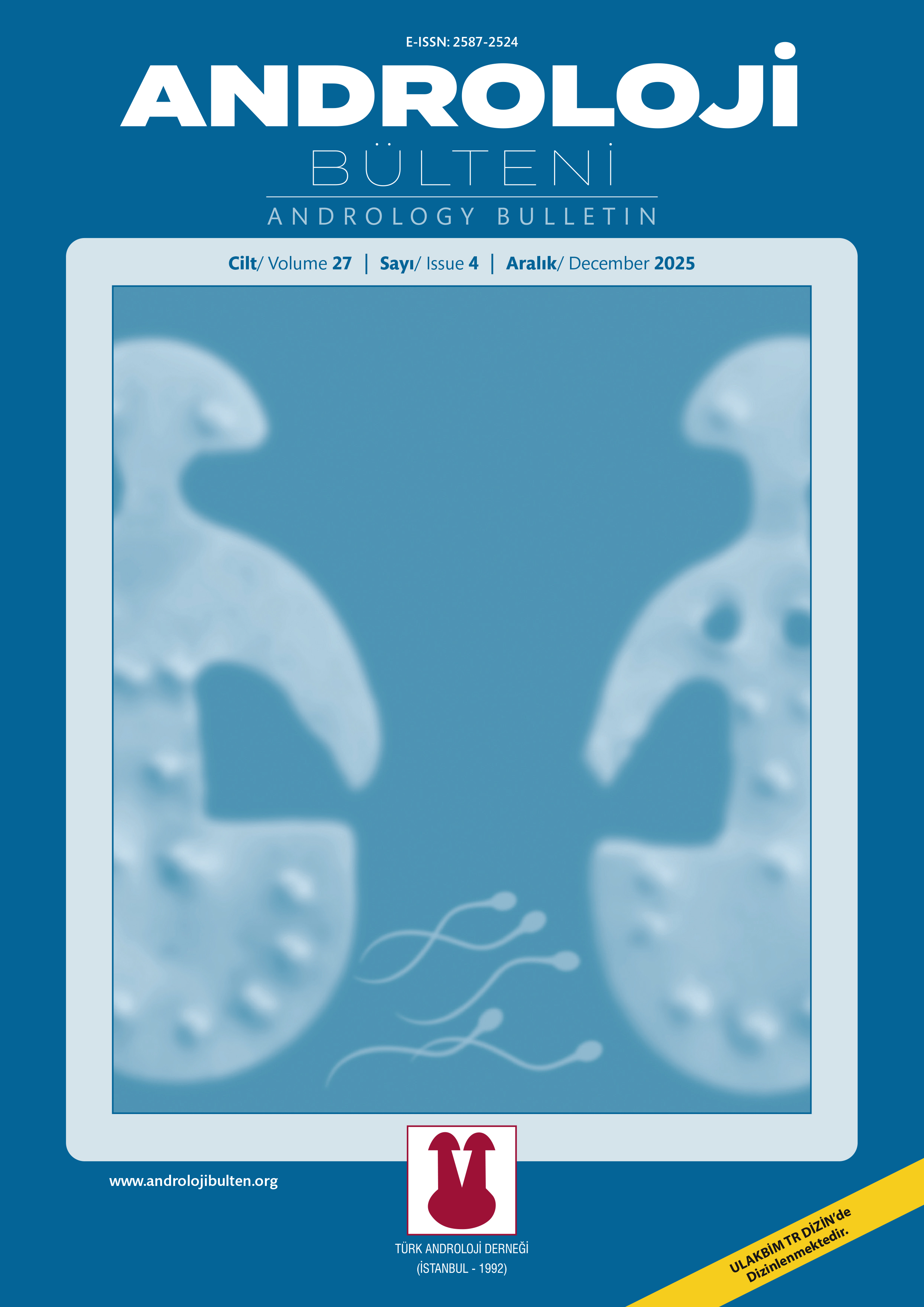
Bu derginin içeriği Creative Commons Atıf-GayriTicari 4.0 Uluslararası Lisansı kapsamında lisanslanmıştır.
Beden kitle indeksinin, klasik sperm parametreleri ve sperm DNA fragmantasyonu ile ilişkisinin incelenmesi: Kesitsel bir araştırma
Semiye Elif Elkatmış1, Emre Salabas21Biruni Üniversite Hastanesi, Histoloji ve Embriyoloji Anabilim Dalı, İstanbul, Türkiye2Şişli Hamidiye Etfal Eğitim ve Araştırma Hastanesi, Üroloji Anabilim Dalı, İstanbul, Türkiye
AMAÇ: Gelişmiş ülkelerdeki yaşam tarzı değişiklileri sebebiyle artan obez ve aşırı kilolu kişilerin sayısı, dünya çapında bir sağlık problemi hale gelmiştir. Obezite, ek komorbid hastalıklara, hormonal bozulmalara, serbest oksijen radikal artışına sebep olarak, üreme fonksiyonunu olumsuz yönde etkilemektedir. Çalışmamızın amacı, beden kitle indeksinin hem klasik sperm parametreleri hem de fonksiyonel sperm kalitesi üzerindeki etkilerini araştırmaktır.
GEREÇ ve YÖNTEMLER: Hastanemizde semen analizi yapılan erkekler, ideal kilolu (1. Grup), fazla kilolu (2. Grup) ve obez (3. Grup) olmak üzere üç gruba ayrılmış, bireylerde klasik sperm parametreleri ve sperm DNA yapısı incelenmiştir. Her üç grupta da standart semen analizinin yanında, sperm DNA fragmantasyon (SDF) testi için akridin oranj, maturasyon analizi için anilin mavisi (AB), sperm kromatin kondensasyonu için kromomisin A3 (CMA3) boyama yöntemi kullanıldı.
BULGULAR: Obezitenin, sperm konsantrasyonunu (1. Grup: 55,0 milyon/ml, 2. Grup: 64,2 milyon/ml, 3. Grup: 47,7 milyon/ml; p>0,1) ve ileri hareketliğini (1. Grup: %41,0, 2. Grup: %42,6, 3. Grup: %35,5; p>0,1) istatistiki olarak etkilemediği görülürken, normal sperm morfolojisi obez grupta daha düşük bulunmuştur (1. Grup: %4,0, 2. Grup: %4,9, 3. Grup: %3,2; p<0,05). Sperm DNA testlerinde, obezite grubundaki erkeklerde, anilin mavisi pozitifliğinin, (1. Grup: %42,5, 2. Grup: %40,8, 3. Grup: %67,8; p<0,01), CMA 3 yüksekliğinin (1. Grup=%38,9, 2. Grup=%45,4, 3. Grup=%65,3; p=0,001) ve akridin oranj tutulumunun (1. Grup: %44,9, 2. Grup: %45,4, 3. Grup: %67,2; p<0,01) anlamlı oranda fazla olduğu görülmüştür.
SONUÇ: Gruplar arasında konsantrasyon, hareketlilik gibi klasik sperm parametrelerinde anlamlı farklılık görülmezken, sperm morfolojisinin obez grupta daha kötü olduğu görülmüştür. Ayrıca obez erkeklerin, normal ve fazla kilolu erkeklere göre anlamlı oranda daha yüksek SDF yüzdesine (akridin oranj), protaminasyon kusuruna (CMA 3) ve maturasyon eksikliğine (anilin mavisi) sahip olduğu gösterilmiştir. Sperm DNA hasarının, spontan gebelik ve yardımcı üreme yöntemlerinin başarısı ile bağlantısı düşünülürse, açıklanmayan infertilite ve erkek faktörü olan obez erkeklerde, klasik sperm parametreleri normal olsa dahi sperm DNA testleri önerilebilir.
Anahtar Kelimeler: Infertility, male, SDF, obesity sperm
Investigation of the association between body mass index, classical sperm parameters and sperm DNA fragmentation: A cross-sectional study
Semiye Elif Elkatmış1, Emre Salabas21Biruni University Hospital2Sisli Hamidiye Etfal Training and Research Hospital
OBJECTIVE: The number of over-weight and obese individuals which increase progressively due to the life style changes in developed countries, became a worldwide problem. Obesity has a negative impact on fertility due to comorbid diseases, hormonal disruptions and over production of free oxygen radicals. Our objective was the investigation of the association between body mass index (BMI), classical sperm parameters and sperm DNA integrity.
MATRERIAL and METHODS: Males who had a semen analysis in our hospital were classified into three groups: Ideal weight group (I), overweight group (II) and obese group (III). Standard semen analysis was done in all three groups. Acridine orange was used for DNA fragmentation test, aniline blue was used for maturation analysis, and chromomycin A3 (CMA3) staining method was used for sperm chromatin condensation.
RESULTS: There was no significant different between three groups in terms of sperm concentration (I: 55.0 million/ml, II: 64.2 million/ml, III: 47.7 million/ml; p>0.1) and progressive motility (I: 41.0%, II: 42.6%, III: 35.4%; p>0.1), while normal sperm morphology rate was lower in obese group than the overweight group (I: 4.0%, II: 4.9%, III: 3.1; p<0.05). Male in obese group had significantly higher rates of aniline blue positivity (I: 42.5%, II: 40.8%, III: 67.8%; p<0.01), acridine orange staining (I: 44.9%, II: 45.4%, III: 67.2%; p<0.01) and CMA 3 positivity (I: 38.9%, II: 45.4%, III: 65.3%, p=0.001).
CONCLUSION: Even if the BMI did not have a significant impact on sperm concentration and motility, normal sperm morphology was significantly lower in obese group. Obese males had significantly higher rates of SDF (acridine orange), protamination defect (CMA 3) and maturation deficiency (aniline blue) than their normal and overweight counterparts. Sperm DNA assessment tests (both direct and indirect) may be suggested to obese males with idiopathic and male factor infertility since there is an association between sperm DNA fragmentation and the success rates of spontaneous pregnancy and assisted reproductive techniques.
Keywords: İnfertilite, erkek, SDF, obezite, sperm
Makale Dili: Türkçe
(600 kere indirildi)













